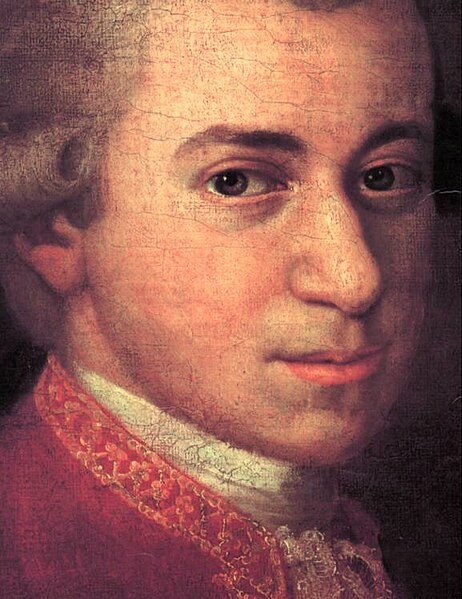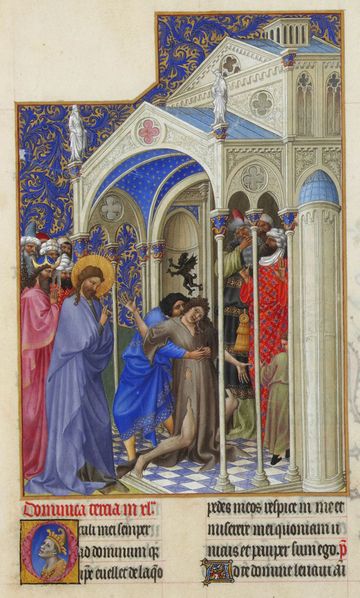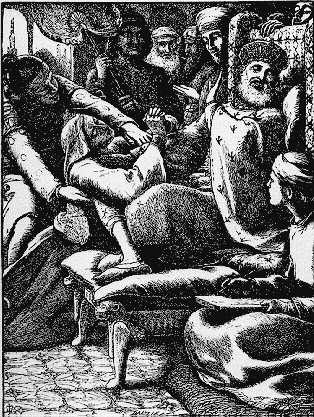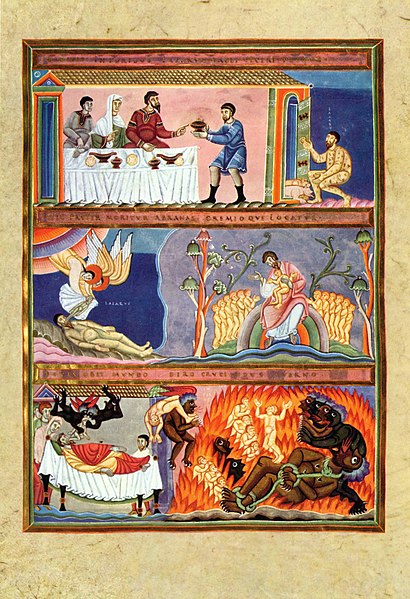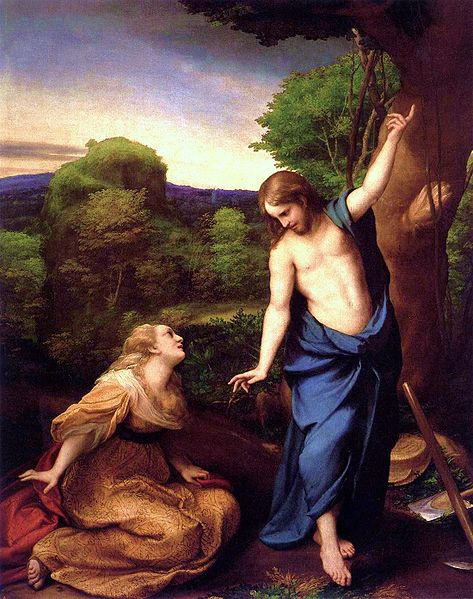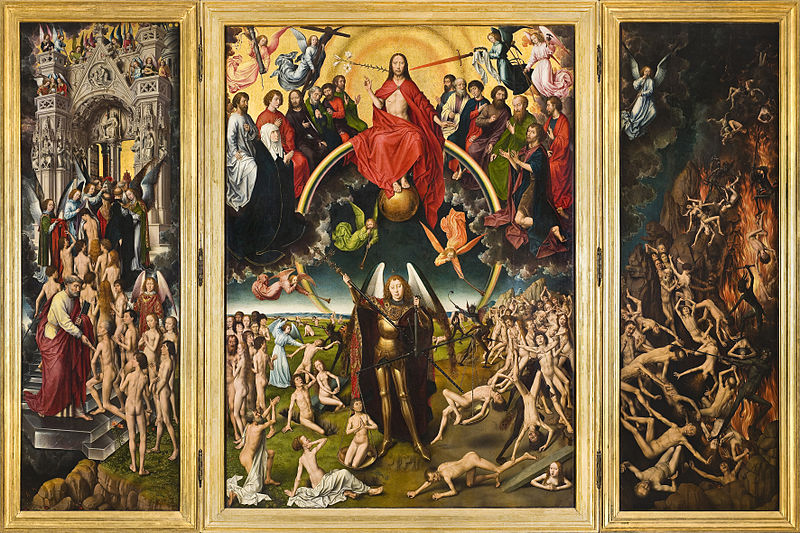"...and said, "Truly I say to you, unless you are converted
and become like children, you will not enter the kingdom of
heaven...." Matthew 18:3, Bible
WOLFGANG AMADEUS MOZART (1756-1791)
Was a prolific and influential composer of the Classical
era. He composed over 600 works, many acknowledged as pinnacles of symphonic,
concertante, chamber, operatic, and choral music. He is among the most
enduringly popular of classical composers... During his final years in Vienna,
he composed many of his best-known symphonies, concertos, and operas, and
portions of the Requiem, which was largely unfinished at the time of his death... The Requiem Mass in D minor (K. 626) by Wolfgang Amadeus
Mozart was composed in Vienna in 1791 and left unfinished at the composer's
death on December 5. A completion by Franz Xaver Süssmayr was delivered to
Count Franz von Walsegg, who had anonymously commissioned the piece for a
requiem Mass to commemorate the February 14 anniversary of his wife's death...
 Requiem in D minor,
K.626
Requiem in D minor,
K.626
 "Requiem" - Ideological
analysis
"Requiem" - Ideological
analysis
"Requiem" by Mozart - as a symbol
of ideological analysis ... of music that reflects the state of the drama, and
the idea of phasing method… conceived
or commissioned Mozart Requiem as a Catholic mass, but the resulting, perhaps,
the most reassuring of all known work…
The
first three parts of "Requiem" gives an image that perfectly
corresponds with what is happening with correctable to treatment, prior to the
correction process, a kind of humanitarian history…
It
starts with the first part of «Requiem aetenam» (eternal peace), as
it were with a person's birth, his childhood - with the "steps" that
are cautious of becoming stronger and more confident, he turns, straightens, a
palette of feelings becomes richer and more perfect. In the infantile Gracious
melodies interject disturbing motives, talking about the big upcoming conflicts
in life…
I.
Introitus: Requiem aetenam
Requiem
aeternam dona eis, Domine,
et lux
perpetua luceat eis.
Te
decet hymnus, Deus, in Sion,
et tibi
reddetur votum in Jerusalem.
Exaudi
orationem meam:
ad te
omnis caro veniet.
Requiem
aeternam dona eis, Domine,
et lux
perpetua luceat eis.
 1.Mozart's
Requiem - I. Introitus-Requiem aeternam
1.Mozart's
Requiem - I. Introitus-Requiem aeternam
http://www.youtube.com/watch?v=DsyPhvrEzPU
In
the second part, in
the face of future trouble is, it would seem, prayer - asking for forgiveness
«Kyrie eleison» (Lord have mercy), but not so simple ...
II.
Kyrie eleison
Kyrie
eleison.
Christe
eleison.
From
prayers are only words. Please pardon sounds demanding, imperative, and
sometimes even threatening, but in the end triumphantly, there is no real
repentance can not be held. An ambitious, arrogant youth can not be
otherwise... The words are repeated, the melody as if walking on the same
circle (fugue) - the problem is the image of cycling, is always present in a
destructive system of relations ("the devil turns,"
"hell"). Destructiveness and evil is always doomed to repeat itself,
circling in the same trajectory…
 Mozart
- Requiem: 2. Kyrie eleison
Mozart
- Requiem: 2. Kyrie eleison
http://www.youtube.com/watch?v=tIhwX7jxBWM&feature=related
The
peak of destruction, "funnel", which end in "hell" - a sort
of catastrophe, disaster, disease. It is the third part of the state transfers - «Dies
irae» (Day of Wrath), written by Mozart under the influence of the plague raged
in Europe from the XIV to XVIII centuries.,
And claimed a total of 75 million lives. And just like the plague, rolled
periodically, and personal negative, do not go all the suffering of cleaning on
the same circle, in the devil's disastrous crazy carousel...
III.
Sequentia: Dies irae
Dies
irae, dies illa,
solvet
saeclum in favilla,
teste
David cum Sibylla.
Quantus
tremor est futurus
quando
judex est venturus,
cuncta
stricte discussurus.
Day of
wrath ... whose anger we have in mind? God? He who, Zeus - the god of thunder,
that's looking for what would be punished? No. This suffering is not of God. A
person willing to endure all sorts of suffering, if only to avoid further
suffering. Afraid of moral suffering, clearing associated with the revaluation
of values, spiritual regeneration, "Resurrection", and cyclic, at
least familiar, but with death, or will judge ...
 3.Mozart's
Requiem-III.Sequentia:Dies irae
3.Mozart's
Requiem-III.Sequentia:Dies irae
http://www.youtube.com/watch?v=ARO7ZjsXSkE&feature=relmfu
And he
comes, but when the person wants this possibility when it comes to the position
of confrontation with the destructiveness: "I have nothing to lose, I'll go
for anything, but as before I will not live." It was at this point, it
amazes sound, solid and confident, inevitably calling "trumpet" - so the next part of the "Requiem." It
is at such moments a person can appeal to ideological analysis...
IV.
Tuba mirum
Tuba
mirum spargens sonum
per
sepulcra regionum,
coget
omnes ante thronum.
Mors stupebit et natura.
Cum
resurget creatura
judicanti
responsura.
Liber
scriptus proferetur
in quo
totum continetur
unde
mundus judicetur.
Judex
ergo cum sedebit
quidquid
latet apparebit:
nil
inultum remanebit.
Quid
sum miser tunc dicturus,
quem
patronum rogaturus,
cum vix
justus sit securus?
 4.Mozart's
Requiem - Tuba mirum
4.Mozart's
Requiem - Tuba mirum
http://www.youtube.com/watch?v=z01Ihw_bqUM&feature=relmfu
So, all
the bridges were burned, the devil is cast out, Judge on the throne - an idea
that lives inside the human ... In the first stage of analysis for the
corrected show through the relationship that he had not previously seen, he
breaks away from the fixation on the material, and more and more affected the
value of ideas in his life and the environment. This change is related to
the intangible is expressed in the following part of the "Requiem" ...
V.
Rex tremendae majestatis
Rex
tremendae majestatis,
qui
salvandos salvas gratis;
salva
me, fons pietatis.
 5.Mozart's
Requiem - Rex tremendae
5.Mozart's
Requiem - Rex tremendae
http://www.youtube.com/watch?v=-cqBJ51PQQQ&feature=relmfu
Then
begins the painful stage of the analysis. Human suffers overestimating their
past and present, seeing how much evil he has received from the outside and
distributed it himself, for which he paid. On the one hand, there is a process
of harmonization, streamlining, organizing, and on the other - it destroys that
harmony, "destroys the destructive" - his old system of relations.
He's trying to keep something, but the forces are less, "barrel" is
spreading, nothing to plug. This reflects the law - the evil, destructive, when
deprived of his enemy, and, in essence, an ally - a human contend its destructiveness
to self and deletes itself. These conditions are reflected in the
next section..
VI.
Recordare
Recordare,
Jesu pie,
quod
sum causa tuae viae
ne me
perdas illa die.
Quaerens
me sedisti lassus;
redemisti
crucem passus.
Tantus
labor non sit cassus.
Juste
Judex ultionis
donum
fac remissionis
ante
diem rationis.
Ingemisco
tanquam reus:
culpa
rubet vultus meus.
supplicanti
parce, Deus.
Qui
Mariam absolvisti
et
latronem exaudisti,
mihi
qouque spem dedisti.
Preces
meae non sunt dignae,
sed tu
bonus fac benigne,
ne perenni
cremer igne.
Inter
oves locum praesta
et ab
haedis me sequestra,
statuens
in parte dextra.
 6.Mozart's
Requiem – Recordare
6.Mozart's
Requiem – Recordare
http://www.youtube.com/watch?v=f9kp6pI3Or4&feature=relmfu
The
process of moral suffering reaches its climax in the chorus of «Confutatis maledictis» (whoever curses overthrown)
... This is the "Calvary" ...
Finally and irrevocably stuck arrows violin passages in the body, afflicted,
possessed destructive. During this period of correction exacerbated not only
moral, ideological feelings, and medical symptoms, there are those, which did
not exist. Adjustable complains of deterioration. The music is expressed by
exploding weak and powerless prayers: «Voca me ...»...
VII.
Confutatis maledictis
Confutatis
maledictis
flammis
acribus addictis,
voca me
cum benedictis.
Oro
supplex el acclinis
cor
contritum quasi cinis,
gere
curam mei finis.
 7.Mozart's
Requiem-Confutatis
7.Mozart's
Requiem-Confutatis
http://www.youtube.com/watch?v=AxwiLowC44I&feature=relmfu
If you
go back to the image of "steps" of a person at the beginning of the
Requiem, the «Confutatis» begins with a terrible, violent, if not - the mad
step. This powerful march of times, stopping to rest, it sounds helpless «Voca
me ...», and forward again: «Confutatis maledictis ...» Next step is exhaled,
the image of human could barely move his legs, weaker and weaker, and at the
end ... stop and drop a man fell to the ground - it sounds completely separate
tertskvartakkord, chord - a sigh, looking for help. And then begins «Lacrimosa» (tear) - most probably the
saddest piece of the famous...
VIII.
Lacrimosa dies illa
Lacrimosa
dies illa
qua
resurget ex favilla
judicandus
homo reus.
Huic
ergo parce, Deus,
pie
Jesu Domine:
dona
eis requiem. Amen.
This is
not the way of steps, it is creeping movement of the last forces of human.
Incredible rhythm of "Lacrimosa" - almost "thready pulse"
rare beats in 12 fractions, enters into a special experience of death is not a
funeral march, it is something much deeper. Movements become weaker and weaker,
and all end stop. The long underlined "Amen" is divided into two
syllables, which ends with "Lacrimosa" - is like two stroke that put
a final end to the old ending of life...
This
point separates the "Requiem" in two radically different halves. The
same thing happens when ideology correction: the negative end, suffering,
begins a positive step...
 8.Mozart's
Requiem-Lacrimosa
8.Mozart's
Requiem-Lacrimosa
http://www.youtube.com/watch?v=JE2muDZksP4&feature=relmfu
In
"Requiem" is «Domine», and there are not any pictures of the
afterlife, no longer infernal sounds. Out of "pacing", which began
with the establishment of a children's «Requiem aetenam» and came to breaking
the march, fight, fall in «Confutatis», and the last movements of crawling in
the «Lacrimosa». Next - flying, higher and higher...
IX.
Offertorium: Domine
Domine
Jesu Christe, Rex gloriae,
libera
animas omnium fidelium
defunctorum
de
poenis inferni et de profundo lacu.
Libera
eas de ore leonis,
ne
absorbeat eas Tartarus,
ne
cadant in obscurum.
Sed
signifer sanctus Michael
repraesentet
eas in lucem sanctam:
quam
olim Abrahae promisisti
et
semini eius.
In
«Domine» reflects the state where the old has died out, and the new has not yet
emerged. Discover striking vigorous freshness «Sed signifer sanctus Michael
...», there is room for tragedy, there is a positive assurance of a new desire,
a kind of impatience that gets a little old, circular: «quam olim Abrahae
promisisti ...», but that's not what we heard in «Kyrie», no longer the grim
demands, and break off these "circles" beautiful code... The same
thing happens with correctable: setbacks, he interrupts himself, and sometimes
even laugh at themselves ...
 9.Mozart's
Requiem: IV. Offertorium: Domine Jesu
9.Mozart's
Requiem: IV. Offertorium: Domine Jesu
http://www.youtube.com/watch?v=0gGMZsPpGug&feature=relmfu
Further
positive formation is presented in an unusually harmonious choir «Hostias». Where once there was a
conflict, now - harmony. Instead of fighting with the bad, stands next to a
good connection...
X.
Hostias
Hostias
et preces tibi, Domine,
laudis
offerimus.
Tu
suscipe pro animabus illis
quarum
hodie memoriam facimus:
fac
eas, Domine,
de
morte transire ad vitam,
quam
olim Abrahae promisisti
et
semini eius.
Again,
in the end breaks the circular «quam olim Abrahae promisisti ...», and again
the same chime ends...
 10.Mozart's
Requiem – Hostias
10.Mozart's
Requiem – Hostias
http://www.youtube.com/watch?v=1b37MbFqhak&feature=relmfu
Next is
a hymn to God: «Sanctus» (saint). A human comes to
holiness - become a servant of the ideas, attitudes, kindness, love and
happiness. ...
XI.
Sanctus
Sanctus,
sanctus, sanctus,
Domine
Deus Sabaoth!
Pleni
sunt coeli et terra gloria tua.
Hosanna
in excelsis.
 11.Mozart's
Requiem - V. Sanctus
11.Mozart's
Requiem - V. Sanctus
http://www.youtube.com/watch?v=vHw0hGvt3y4&feature=relmfu
The
same reflects the following part: «Benedictus», but calmly, without the
solemnity, the first excitement goes...
XII.
Benedictus
Benedictus
qui venit
in
nomine Domini.
Hosanna
in excelsis.
 12.Mozart's
Requiem – Benedictus
12.Mozart's
Requiem – Benedictus
http://www.youtube.com/watch?v=SPI8yzBdmzI&feature=relmfu
The
next section «Agnus
Dei» (Lamb
of God) manifests the essence of the new updated card: if you had actually been
his own suffering, but now there is compassion, understanding yourself and
others ...
XIII.
Agnus Dei
Agnus
Dei, qui tollis peccata mundi,
dona eis
requiem.
Agnus
Dei, qui tollis peccata mundi,
dona
eis requiem sempiternam.
 13.Mozart's
Requiem - VI. Agnus Dei
13.Mozart's
Requiem - VI. Agnus Dei
http://www.youtube.com/watch?v=4-nW3j6FGyE&feature=relmfu
Completes
the product side, repeating the same motif, which begins with "Requiem",
which draws the birth, childhood, becoming a human, but is now cleared of
anxiety...
XIV.
Communio Lux aeterna
Lux
aeterna luceat eis, Domine,
cum
sanctis tuis in aeternam,
quia
pius est.
 14.Mozart's
Requiem - VII. Communion: Lux aeterna
14.Mozart's
Requiem - VII. Communion: Lux aeterna
http://www.youtube.com/watch?v=ovftir5lgwQ&feature=relmfu
 Maturity
and perfection of human merged with childhood ... The genius of Mozart overcame
time and showed that we can more or less justified only now - to overcome old
age, sickness and death can only be based on the update human, its re-thinking
of the lost children's characteristics (mobility, flexibility, agility ..) ...
Maturity
and perfection of human merged with childhood ... The genius of Mozart overcame
time and showed that we can more or less justified only now - to overcome old
age, sickness and death can only be based on the update human, its re-thinking
of the lost children's characteristics (mobility, flexibility, agility ..) ...
This is the meaning of the covenant of the
Gospel, "Be as little children" ...
Any
person, if entered into war with the bias-destructiveness (in religion -
sinfulness), on their own experiences all the same stages, the same state... where the
destruction of the reversible and pour in the update -
"Resurrection," a qualitative leap, actualized in the life of an
idealistic human of happiness, freedom, creativity, love ...
 "Dies Irae" (Day of Wrath) is a thirteenth
century Latin hymn...
"Dies Irae" (Day of Wrath) is a thirteenth
century Latin hymn...
The
Latin text below is taken from the Requiem Mass in the 1962 Roman Missal. The
first English version below, translated by William Josiah Irons in 1849,[4]
replicates the rhyme and metre of the original. The second English version is a more formal equivalence....
1
|
Dies
irж! Dies illa
Solvet sжclum in favilla:
Teste David cum Sibylla!
|
Day
of wrath! O day of mourning!
See fulfilled the prophets' warning,
Heaven and earth in ashes burning!
|
The
day of wrath, that day
Will dissolve the world in ashes
As foretold by David and the sibyl!
|
2
|
Quantus
tremor est futurus,
Quando iudex est venturus,
Cuncta stricte discussurus!
|
Oh,
what fear man's bosom rendeth,
when from heaven the Judge descendeth,
on whose sentence all dependeth.
|
How
much tremor there will be,
when the judge will come,
investigating everything strictly!
|
3
|
Tuba
mirum spargens sonum
Per sepulchra regionum,
Coget omnes ante thronum.
|
Wondrous
sound the trumpet flingeth;
through earth's sepulchers it ringeth;
all before the throne it bringeth.
|
The
trumpet, scattering a wondrous sound
through the sepulchres of the regions,
will summon all before the throne.
|
4
|
Mors
stupebit, et natura,
Cum resurget creatura,
Iudicanti responsura.
|
Death
is struck, and nature quaking,
all creation is awaking,
to its Judge an answer making.
|
Death
and nature will marvel,
when the creature arises,
to respond to the Judge.
|
5
|
Liber
scriptus proferetur,
In quo totum continetur,
Unde mundus iudicetur.
|
Lo!
the book, exactly worded,
wherein all hath been recorded:
thence shall judgment be awarded.
|
The
written book will be brought forth,
in which all is contained,
from which the world shall be judged.
|
6
|
Iudex
ergo cum sedebit,
Quidquid latet, apparebit:
Nil inultum remanebit.
|
When
the Judge his seat attaineth,
and each hidden deed arraigneth,
nothing unavenged remaineth.
|
When
therefore the judge will sit,
whatever hides will appear:
nothing will remain unpunished.
|
7
|
Quid
sum miser tunc dicturus?
Quem patronum rogaturus,
Cum vix iustus sit securus?
|
What
shall I, frail man, be pleading?
Who for me be interceding,
when the just are mercy needing?
|
What
am I, miserable, then to say?
Which patron to ask,
when [even] the just may [only] hardly be sure?
|
8
|
Rex
tremendж maiestatis,
Qui salvandos salvas gratis,
Salva me, fons pietatis.
|
King
of Majesty tremendous,
who dost free salvation send us,
Fount of pity, then befriend us!
|
King
of tremendous majesty,
who freely savest those that have to be saved,
save me, source of mercy.
|
9
|
Recordare,
Iesu pie,
Quod sum causa tuж viж:
Ne me perdas illa die.
|
Think,
good Jesus, my salvation
cost thy wondrous Incarnation;
leave me not to reprobation!
|
Remember,
merciful Jesus,
that I am the cause of thy way:
lest thou lose me in that day.
|
10
|
Quжrens
me, sedisti lassus:
Redemisti Crucem passus:
Tantus labor non sit cassus.
|
Faint
and weary, thou hast sought me,
on the cross of suffering bought me.
shall such grace be vainly brought me?
|
Seeking
me, thou sat tired:
thou redeemed [me] having suffered the Cross:
let not so much hardship be lost.
|
11
|
Iuste
iudex ultionis,
Donum fac remissionis
Ante diem rationis.
|
Righteous
Judge! for sin's pollution
grant thy gift of absolution,
ere the day of retribution.
|
Just
judge of revenge,
give the gift of remission
before the day of reckoning.
|
12
|
Ingemisco,
tamquam reus:
Culpa rubet vultus meus:
Supplicanti parce, Deus.
|
Guilty,
now I pour my moaning,
all my shame with anguish owning;
spare, O God, thy suppliant groaning!
|
I
sigh, like the guilty one:
my face reddens in guilt:
Spare the supplicating one, God.
|
13
|
Qui
Mariam absolvisti,
Et latronem exaudisti,
Mihi quoque spem dedisti.
|
Thou
the sinful woman savedst;
thou the dying thief forgavest;
and to me a hope vouchsafest.
|
Thou
who absolved Mary,
and heardest the robber,
gavest hope to me, too.
|
14
|
Preces
meж non sunt dignж:
Sed tu bonus fac benigne,
Ne perenni cremer igne.
|
Worthless
are my prayers and sighing,
yet, good Lord, in grace complying,
rescue me from fires undying!
|
My
prayers are not worthy:
however, thou, Good [Lord], do good,
lest I am burned up by eternal fire.
|
15
|
Inter
oves locum prжsta,
Et ab hжdis me sequestra,
Statuens in parte dextra.
|
With
thy favored sheep O place me;
nor among the goats abase me;
but to thy right hand upraise me.
|
Grant
me a place among the sheep,
and take me out from among the goats,
setting me on the right side.
|
16
|
Confutatis
maledictis,
Flammis acribus addictis:
Voca me cum benedictis.
|
While
the wicked are confounded,
doomed to flames of woe unbounded
call me with thy saints surrounded.
|
Once
the cursed have been rebuked,
sentenced to acrid flames:
Call thou me with the blessed.
|
17
|
Oro
supplex et acclinis,
Cor contritum quasi cinis:
Gere curam mei finis.
|
Low I
kneel, with heart submission,
see, like ashes, my contrition;
help me in my last condition.
|
I
meekly and humbly pray,
[my] heart is as crushed as the ashes:
perform the healing of mine end.
|
18
|
Lacrimosa
dies illa,
qua resurget ex favilla
Iudicandus homo reus.
Huic ergo parce, Deus:
|
Ah!
that day of tears and mourning!
From the dust of earth returning
man for judgment must prepare him;
Spare, O God, in mercy spare him!
|
Tearful
will be that day,
on which from the ash arises
the guilty man who is to be judged.
Spare him therefore, God.
|
19
|
Pie
Iesu Domine,
dona eis requiem. Amen.
|
Lord,
all pitying, Jesus blest,
grant them thine eternal rest. Amen.
|
Merciful
Lord Jesus,
grant them rest. Amen.
|
Pie
Jesu is a
motet derived from the final couplet of the Dies irae and often included in
musical settings of the Requiem Mass....
Volfgangas Amadėjus
Mocartas (Johann Chrysostomus Wolfgangus Theophilus Mozart;
1756 m. sausio 27 d. Zalcburge – 1791 m. gruodžio 5 d. Vienoje) – austrų
kompozitorius, vienas žymiausių ir įtakingiausių klasicistinės muzikos
kompozitorių...
Requiem Mass in D
minor (K. 626) –
viena žymiausių Volfgango Amadėjaus Mocarto kompozicijų, užbaigta 1791 m. Tai
buvo paskutinis Mocarto muzikinis darbas, tačiau liko nepabaigtas. Po Mocarto mirties Requiem užbaigė jo kolega Franz Xaver
Süssmayr....
 "...ir
tarė: 'Iš tiesų sakau jums: jeigu neatsiversite
ir nepasidarysite kaip maži vaikai, niekaip neįeisite į dangaus
karalystę..." Mato 18,3 Biblija
"...ir
tarė: 'Iš tiesų sakau jums: jeigu neatsiversite
ir nepasidarysite kaip maži vaikai, niekaip neįeisite į dangaus
karalystę..." Mato 18,3 Biblija
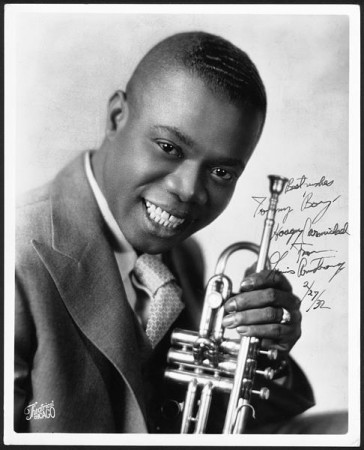




 Jazz music
Jazz music

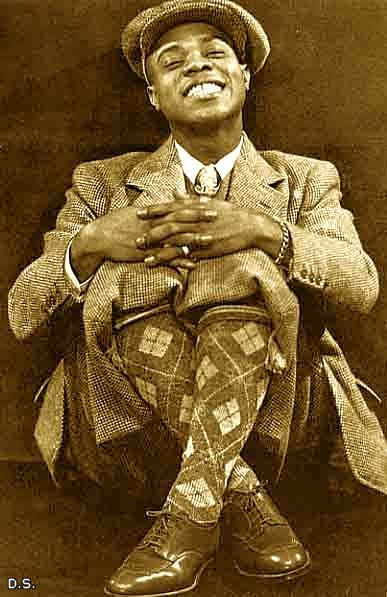
 Louis Armstrong - a
black boy with a Jewish star
Louis Armstrong - a
black boy with a Jewish star




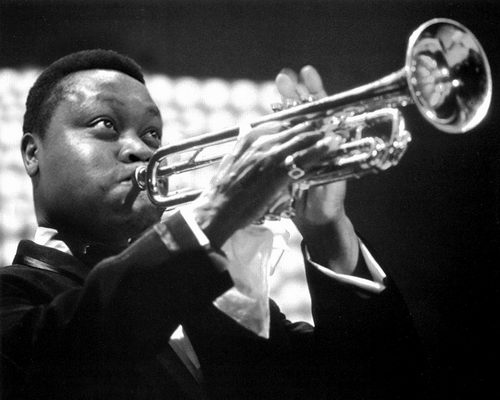
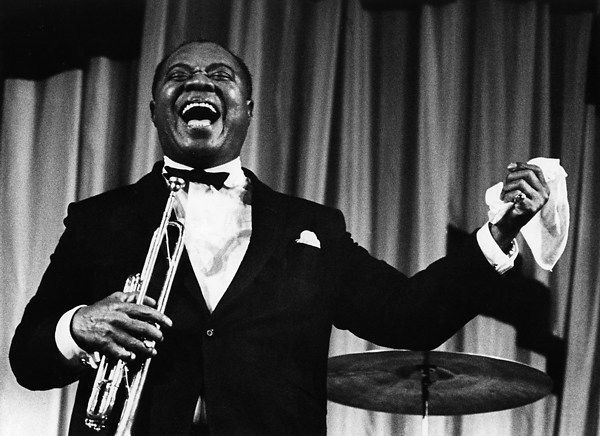




 Louis Armstrong - Saint Louis Blues
Louis Armstrong - Saint Louis Blues  Louis Armstrong - West End Blues 1928
Louis Armstrong - West End Blues 1928 What a wonderful world - LOUIS ARMSTRONG.
What a wonderful world - LOUIS ARMSTRONG. Louis Armstrong-Heebie Jeebies
Louis Armstrong-Heebie Jeebies Louis Armstrong - All Of Me
Louis Armstrong - All Of Me Louis Armstrong - Hello Dolly
Louis Armstrong - Hello Dolly Louis Armstrong Weather Bird
Louis Armstrong Weather Bird Louis Armstrong - Mack the Knife
Louis Armstrong - Mack the Knife Louis Armstrong
:::: Hey Lawdy Mama.
Louis Armstrong
:::: Hey Lawdy Mama. LOUIS ARMSTRONG -
let's do it (let's fall in love)
LOUIS ARMSTRONG -
let's do it (let's fall in love) Dream a Little
Dream by Louis Armstrong
Dream a Little
Dream by Louis Armstrong Louis Armstrong -
Blueberry Hill
Louis Armstrong -
Blueberry Hill Louis Armstrong -
Blue Moon
Louis Armstrong -
Blue Moon Louis Armstrong:
St. James Infirmary
Louis Armstrong:
St. James Infirmary Louis
Armstrong-Go Down Moses
Louis
Armstrong-Go Down Moses
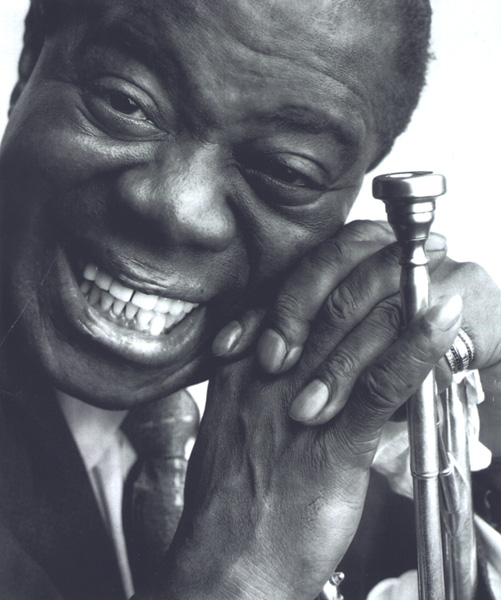
 Džiazo simbolis - Louis Armstrong
Džiazo simbolis - Louis Armstrong 







